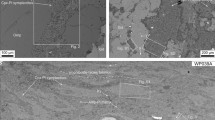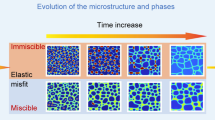Abstract
Pyroxenes of pigeonitic and augitic bulk compositions in H3–4 chondritic meteorites commonly exhibit sigmoidal precipitates, rather than the elsewhere common lamellar associations. Most often, submicrometric sigmoids with calcic clinopyroxene composition occur within clinoenstatite; more rarely, clinoenstatite sigmoids occur within calcic clinopyroxene. The sigmoids appear as ‘001’ terminated lamellae, with terminations rotated in opposite directions towards the ‘100’ orientation. Pre-exsolution pigeonite and augite formed at temperatures higher than 980 °C, whereas sigmoidal exsolution occurred between 990 and 830 °C. Local anomalous lattice parameters determined by electron diffraction suggest that lattice parameters are most strained where the exsolution texture is most poorly defined. Shear strain occurs during exsolution due to mismatching lattice parameters and variable β angles. In response to shear stress, the lamellae relax and assume sigmoidal strained morphologies. Sigmoidal exsolution is strongly controlled by (100) orthoenstatite stacking faults that possibly trigger exsolution.
Similar content being viewed by others
Acknowledgments.
We thank Dr. S. Weinbruch and an anonymous referee for the useful comments, and Prof. A. Putnis for editorial assistance.
Author information
Authors and Affiliations
Corresponding author
Rights and permissions
About this article
Cite this article
Ferraris, C., Folco, L. & Mellini, M. Sigmoidal exsolution by internal shear stress in pyroxenes from chondritic meteorites. Phys Chem Minerals 30, 503–510 (2003). https://doi.org/10.1007/s00269-003-0349-8
Received:
Accepted:
Issue Date:
DOI: https://doi.org/10.1007/s00269-003-0349-8




